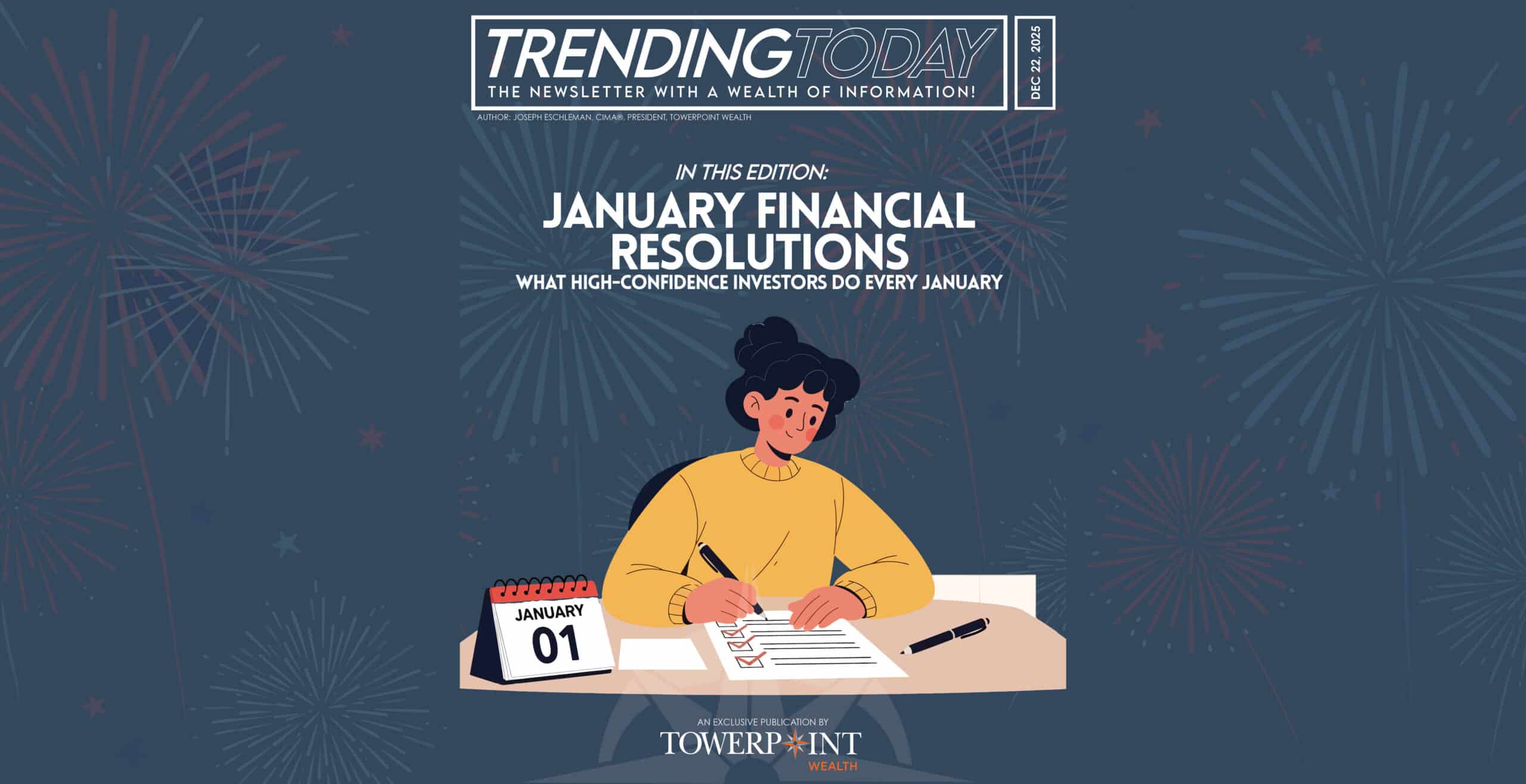The 60/40 Portfolio at a Crossroads
The 60/40 portfolio has been one of the most widely recognized investment strategies in the world of wealth management for the past few decades. Traditionally composed of 60 percent stocks and 40 percent bonds, it became a benchmark for balanced investing because it offered both growth potential and downside protection. This combination of two asset classes has historically delivered a smooth ride for long term investors, making it a core approach for many investors with moderate risk tolerance.
In 2025, however, the financial markets look very different than they did when the 60/40 portfolio first gained popularity. The past few years have tested the model as never before, leading many investors, financial advisors, and chief investment strategists to reconsider how asset allocation should evolve. At Towerpoint Wealth, we believe the principles of portfolio diversification, strategic asset allocation, and disciplined investment management remain powerful, but they must be adapted to reflect today’s interest rates, bond prices, and broader economic environments.
What is the 60/40 Portfolio and Why It Worked for Decades

The Traditional Allocation Explained
A 60/40 portfolio simply refers to an investment mix where 60 percent is allocated to a stock portfolio and 40 percent to fixed income investments such as government or corporate bonds. This approach draws heavily on modern portfolio theory, which suggests that combining major asset classes that tend to behave differently can help manage risk and improve risk adjusted performance. The idea is that when one asset class underperforms, the other may be in positive territory, smoothing overall results.
Why It Became a Standard
For many investors, the 60/40 portfolio represented a sensible compromise between the potential higher returns of an all stock portfolio and the stability of bonds. Over the past decade, its past performance has been impressive. Even after periods of market stress, the strategy has historically recovered, thanks to the tendency of stocks and bonds to move in opposite directions. Falling interest rates for much of the past few decades boosted bond prices, while economic growth supported the stock market. Many investors saw this as a way to earn more money over time while avoiding some of the volatility associated with more aggressive investment strategies.
How the 60/40 Portfolio Has Performed Recently
The Historic 2022–2024 Drawdown
The 60/40 portfolio faced one of its worst performances in living memory when both stocks and bonds declined sharply in 2022. The bond market suffered significant losses as interest rates rose rapidly in response to inflation. At the same time, the stock market fell due to tightening by central banks, geopolitical risks, and slowing growth. The positive correlation between stocks and bonds during this period was rare and damaging, and it reduced the diversification benefit investors had relied on for decades. For many investors, this was the first time they had seen both asset classes perform poorly at the same time.
The 2025 Recovery and Year-to-Date Returns
While the past few years have been challenging, 2025 has brought a strong rebound. As of mid-year, the 60/40 portfolio has returned around 8 percent year-to-date, with the aggregate bond index contributing positively alongside a recovering stock market. Over the past decade, despite recent volatility, the portfolio has delivered solid risk adjusted performance, averaging about 9.1 percent annually. This resilience highlights why many investors continue to view the 60/40 portfolio as a viable foundation for a diversified portfolio, even as they consider alternative investments and other factors in their decision-making.
Why Experts Are Rethinking the Model

Changing Correlations Between Stocks and Bonds
The diversification benefits of holding two asset classes rely on them behaving differently during various market cycles. In recent years, however, a regime change has occurred. Stocks and bonds have at times moved in the same direction, which limits the ability of the 60/40 portfolio to provide downside protection. This shift has caused chief investment officers and senior editors at leading financial publications to question whether the strategy needs substantial revision.
Valuations, Interest Rates, and Bond Prices
Equity valuations remain high, and although bond prices have recovered somewhat from 2022 lows, interest rates are still elevated compared to the past decade. Rising interest rates can hurt bond prices in the short term, but they also create better expected returns for fixed income going forward. Investors must weigh these trade-offs, especially if they have more risk in their portfolio than they can tolerate.
The Role of Alternative Investments and More Diversification
Many investors are exploring alternative investments such as private credit, infrastructure, and real assets to supplement traditional stocks and bonds. Adding these can provide more diversification and potentially better risk adjusted performance, particularly in periods of inflation shock or market stress. Strategic asset allocation now often includes high yield bonds, international stocks, and even commodities to manage risk factors more effectively.
Adapting the 60/40 Portfolio for Today’s Markets

Tilt Toward Bonds or Alternatives
With higher interest rates offering improved yields, some investors are increasing their allocation to fixed income. Shorter duration bonds, floating-rate debt, and Treasury Inflation-Protected Securities (TIPS) can help reduce interest rate risk. At the same time, adding alternative investments like hedge funds or private markets can provide returns that are less dependent on the performance of the stock market.
Incorporating Real Assets and Inflation Hedges
Real assets such as gold, commodities, and REITs can act as a hedge against inflation and provide additional sources of return. They often behave differently than traditional asset classes, which can improve portfolio diversification.
Leveraging International Stocks and High Yield Bonds
International stocks can offer exposure to economic environments and central bank policies that differ from those in the United States. High yield bonds, while riskier, can provide higher income and further diversify a fixed income allocation.
Active Rebalancing and Portfolio Analysis
Maintaining a diversified portfolio in today’s markets requires active monitoring. An actively managed fund or tailored investment strategy can help ensure that allocations remain aligned with investment objectives and risk tolerance. Regular portfolio analysis can reveal when adjustments are needed to maintain better risk adjusted performance.
Who Should Still Consider a 60/40 Portfolio

The Risk-Moderate Investor
For investors seeking balanced exposure to the stock market and bond market, a 60/40 portfolio still offers a reasonable starting point.
Retirees with Reliable Income
Those whose essential expenses are covered by pensions, Social Security, or other predictable income streams can use the 60/40 approach as part of a strategy to preserve financial security without taking on more risk than necessary.
High-Net-Worth Individuals Seeking a Core Allocation
When combined with other asset classes in a broader plan, the 60/40 mix can serve as the anchor of a diversified portfolio, with alternative investments and real assets providing additional layers of return and protection.
The Importance of Personalization
Goals-Based Wealth Management
Asset allocation should always align with personal goals, time horizons, and investment objectives. Many investors need a customized investment strategy rather than a one-size-fits-all model.
Stress Testing in Different Economic Environments
Running simulations can help identify how a portfolio might perform under various conditions, from rising interest rates to recession. This helps manage risk and avoid surprises that can derail future results.
Working with a Financial Advisor
A qualified financial advisor can provide investment advice tailored to your needs, ensuring that your portfolio is constructed to meet your objectives and adjusted as market conditions evolve.
Case Study – Modernizing a 60/40 Portfolio
Consider a retired couple with $5 million in investable assets. They began 2023 with a traditional 60/40 portfolio. Concerned about interest rate risk and market stress, they worked with our team to reallocate 10 percent from equities into private credit and infrastructure, reduced bond duration, and added a 5 percent allocation to real assets. Over 18 months, this approach delivered better risk adjusted performance than a static 60/40 allocation, with lower volatility and higher income.
Frequently Asked 60/40 Portfolio Questions
What is the main advantage of a 60/40 portfolio?
The main advantage is its balance between growth potential from stocks and stability from bonds, offering a diversified portfolio that can smooth out volatility and provide better risk adjusted performance over the long term.
Has the 60/40 portfolio become outdated?
While recent years have challenged the traditional 60/40 allocation due to changing correlations and rising interest rates, the strategy remains relevant. However, it requires adaptation, such as incorporating alternative investments and adjusting bond durations to fit modern economic environments.
How do alternative investments fit into a 60/40 portfolio?
Alternative investments such as private credit, infrastructure, and real assets can complement the traditional stock and bond mix by providing exposure to assets that behave differently, enhancing diversification and potentially improving returns and downside protection.
Should I increase my bond allocation given the recent rise in interest rates?
Higher interest rates can lead to better yields on bonds, but also increase interest rate risk. Many investors consider shorter duration or inflation-protected bonds to balance these factors while maintaining income and reducing volatility.
Is active management necessary for a modern 60/40 portfolio?
Active management or regular portfolio analysis can help adjust allocations to better align with investment objectives and risk tolerance, especially in today’s dynamic financial markets where correlations and economic conditions can shift rapidly.
Who is the ideal investor for a 60/40 portfolio today?
Investors with moderate risk tolerance, retirees seeking reliable income and preservation of capital, and high-net-worth individuals looking for a core allocation within a broader diversified portfolio may find the 60/40 approach suitable when properly adapted.
How important is personalization in asset allocation?
Personalization is critical. Asset allocation should reflect individual goals, time horizons, and risk tolerance. A one-size-fits-all 60/40 portfolio may not meet everyone’s needs, so working with a financial advisor to customize the strategy is advisable.
Can international stocks improve a 60/40 portfolio?
Yes, international stocks offer exposure to different economic environments and central bank policies, which can improve diversification and help manage risk factors within the portfolio.
What role do real assets play in a 60/40 portfolio?
Real assets like gold, commodities, and REITs act as inflation hedges and often behave differently than stocks and bonds, enhancing diversification and providing additional sources of return in a portfolio.
How often should I rebalance my 60/40 portfolio?
Rebalancing frequency depends on individual strategy and market conditions, but regular reviews, typically quarterly or annually, help maintain the desired asset allocation and manage risk effectively. Active rebalancing may be necessary during periods of significant market volatility.
Conclusion – The Future of the 60/40 Portfolio
The 60/40 portfolio is not obsolete, but the financial markets of 2025 demand a more flexible approach. By incorporating alternative investments, adjusting allocations in response to interest rates, and embracing more diversification across asset classes, investors can position themselves for stronger future results. The past performance of the 60/40 portfolio demonstrates its resilience, but adapting to other factors such as inflation, central bank policy, and changing correlations between stocks and bonds will be critical. For long term investors who want to make more money while controlling risk factors, a modernized 60/40 portfolio can still play a central role in achieving financial security.







